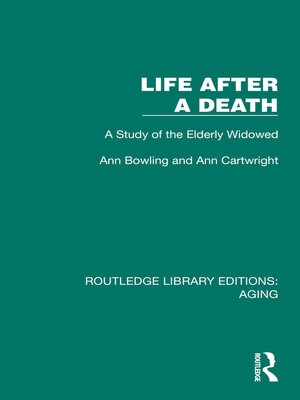Life After a Death
ebook ∣ A Study of the Elderly Widowed · Routledge Library Editions: Aging
By Ann Bowling

Sign up to save your library
With an OverDrive account, you can save your favorite libraries for at-a-glance information about availability. Find out more about OverDrive accounts.
Find this title in Libby, the library reading app by OverDrive.



Search for a digital library with this title
Title found at these libraries:
| Library Name | Distance |
|---|---|
| Loading... |
The recently widowed experience many complex problems, and an understanding of their needs and the kinds of difficulties they encounter is essential if appropriate services and help are to be mobilized. It is the old who are most likely to be widowed, and they may face this crisis at a time when they may also be adjusting to ill health and increasing infirmity, and to retirement, with its problems of role identification and adaptation to an increase in leisure and a decrease in wealth. Most will have to learn to live alone, or to uproot themselves from their home and adjust to life with relatives. Often, the elderly person will have been involved in caring for their spouse during his or her terminal illness; widowhood will mean that they have lost their main occupation. For some, who are themselves disabled, widowhood may mean that they have lost the person who cared for them, so that there is an immediate crisis as alternative sources of care need to be found. These problems have to be faced in a situation often complicated by the anxiety, loneliness, apathy, and bewilderment of bereavement.
Originally published in 1982, Life After A Death presents the results of a study of the experiences and attitudes of over 350 elderly widowed men and women, their general practitioners, and their relatives, friends, and neighbours, and considers the implications of the help the widowed received, or failed to receive, from those to whom it was most likely that they would turn for support. The authors' identification and description of the emotional and practical day-to-day needs of the widowed, and their recommendations about the potential role of the general practitioner and voluntary and social services, should be considered by all those concerned to alleviate the difficulties of the widowed, and to help them to live a better 'life after a death'.







